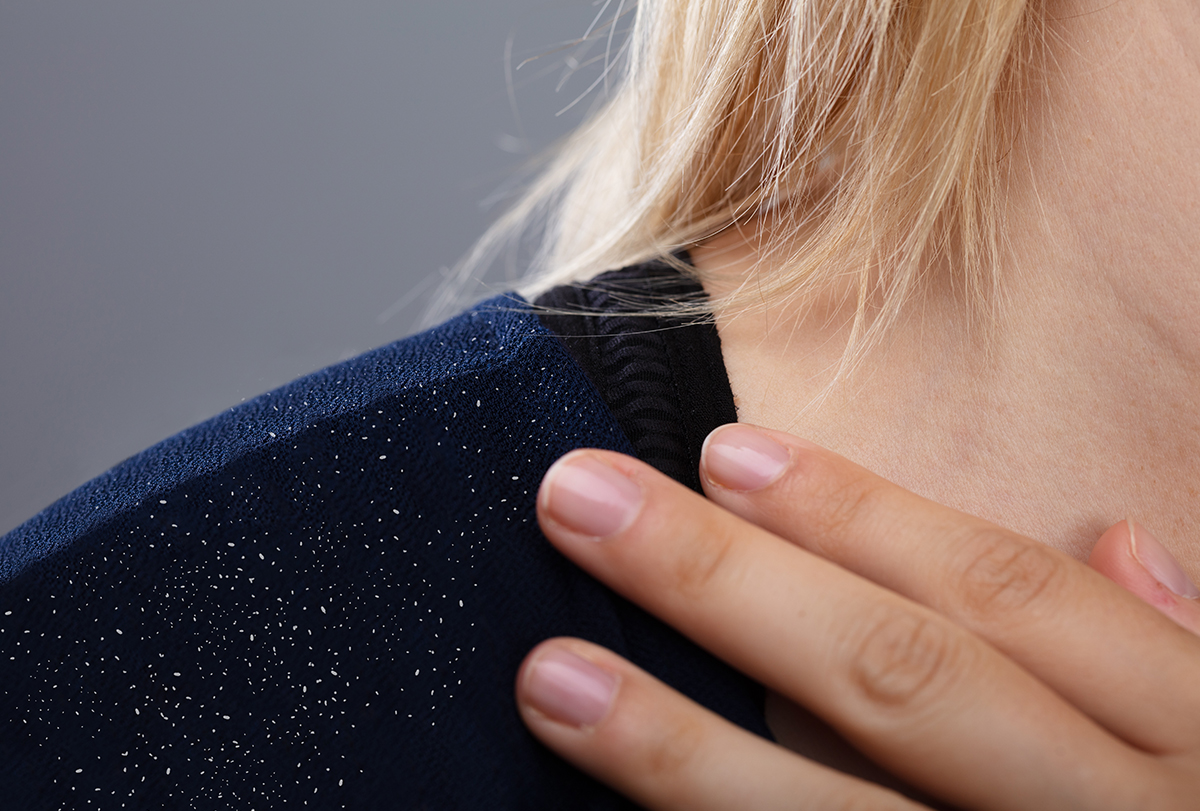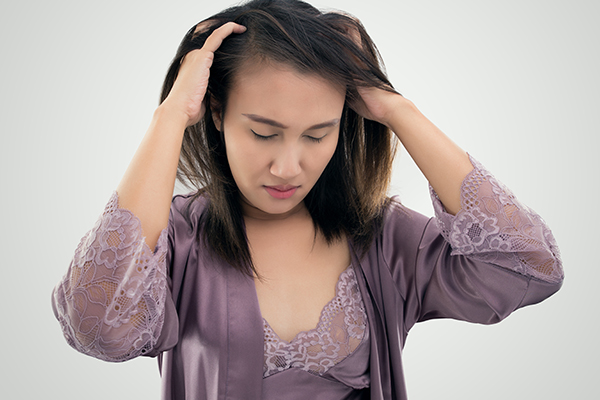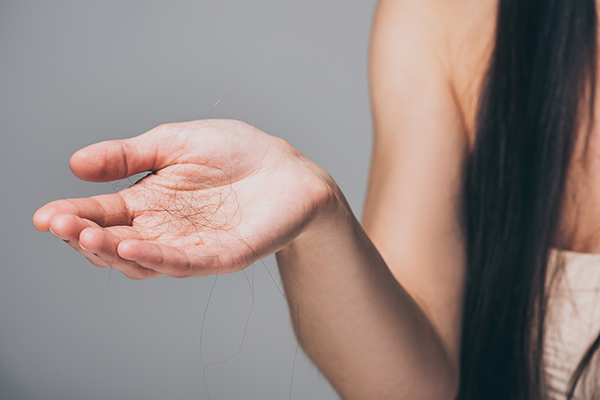In this article:
Dandruff is a common scalp problem that generally causes discomfort and irritation, even becoming a source of embarrassment at times.

Dandruff is mainly characterized by a perpetually dry, itchy scalp that sheds tiny white skin flakes, which make your hair look and feel dirty. Also, the dead skin can build up on your scalp over time and settle inside the hair follicles, making them utterly congested.
Both these factors greatly hamper the follicle’s ability to produce long and strong hair, which is why people with severe untreated dandruff can sometimes suffer from hair shedding.
Plus, the sebum and organic debris collected inside the clogged follicles invite bacteria and other pathogens that feed on this gunk and multiply rapidly to potentially trigger a secondary scalp infection.
Dandruff is basically a noninflammatory form of seborrheic dermatitis/seborrhea that is limited to the scalp and affects people across ages, gender, and race. (1) Even newborn babies get it, referred to as cradle cap.
The good thing is this condition, annoying as it may be, is totally harmless, noncontagious, and easily manageable, usually with simple over-the-counter solutions.
How Common Is Dandruff?
Dandruff affects nearly half of all the people in the world, which points to its overwhelming prevalence. It is especially common among the prepubescent population, with an almost 5% incidence rate. (2)
Cause of Dandruff

The underlying cause of dandruff is still being studied, and so far, it seems to be complex. This condition shares many common features with the scaly skin condition seborrheic dermatitis. In fact, dandruff is generally considered to be a subtype of seborrheic dermatitis, except it is not inflammatory and only affects the scalp.
It is only when the symptoms of dandruff are accompanied by inflammation and the skin scaling spreads beyond the scalp to other parts of the body that the diagnosis of seborrheic dermatitis is made. (3) Otherwise, it is simply dandruff or flaky skin.
Here are some of the main contributing factors that give rise to or worsen dandruff: (4)
- Overgrowth of Malassezia, a yeast that naturally resides on the scalp symbiotically, leading to a fungal infection that makes the scalp skin dry, flaky, and itchy. People with dandruff tend to have 1.5–2 times the normal Malassezia population on their scalp. (4)
- Negligent or improper hair washing leads to further accumulation of dead cells, sebum, and other impurities on the scalp, which can promote the growth of Malassezia.
- A naturally oily scalp is more likely to support fungal overgrowth.
- Some hormonal imbalances cause excessive production of sebum, which provides fodder for Malassezia to grow rapidly and cause an infection.
Symptoms of Dandruff
Dandruff is characterized by the following symptoms:
- Flaky, white, or yellowish skin on the scalp
- Erythema in the affected area, which can make your scalp skin appear silvery rather than red
- Yellow-colored papules or pustules along the hairline in severe cases
- Crusty or scaly scalp
- White or yellowish flakes of dead skin that stick to the hair and sheds on the shoulders
- Itchy scalp of variable severity
- Dryness on the face, forehead, eyebrows, or ears
- Localized skin discoloration, especially in people with darker skin
Treatment Options for Dandruff

There is no cure for dandruff, and the available treatments primarily aim to minimize the symptoms as much as possible. Antidandruff lotions, antifungal shampoos, or salicylic acid shampoos (5) in varying strengths are the first-line treatment for dandruff.
Your dermatologist will recommend the appropriate product for you according to the severity of your condition. Mild dandruff often can be treated with nonprescription shampoos alone that are designed to reduce scalp oiliness, curb fungal growth, reduce the rate of desquamation of skin cells, and exfoliate.
Here are popular varieties of antidandruff shampoos that you can try:
One pro-tip is to alternate between two different antidandruff shampoos such as a keratolytic and antifungal shampoo.
Since dandruff can leave your scalp dry and itchy, make sure your medicated hair products contain one or more moisturizing ingredients, such as aloe vera, (8) honey, (9) oatmeal extracts, (10) and menthol, which will provide hydration to your parched skin. You can also apply hydrating serums after washing your hair to restore moisture to your scalp.
How often you should shampoo depends on how severe your dandruff is. If mild, once or thrice a week is sufficient (about twice for Caucasians and Asians and once for African-Americans). If it is quite bad, you may need to shampoo every day until the condition improves.
You can also try dry brushing your scalp gently to dislodge the loosely attached dandruff flakes from the scalp, especially before using any medicated shampoo. Doing so allows the product to be absorbed faster and better into the scalp.
Note: Consult your doctor on the frequency of using antidandruff shampoo according to the severity of your condition. Tacrolimus or pimecrolimus (calcineurin inhibitors) ointments, corticosteroid creams, and antifungal lotions might be recommended if there is moderate to severe rash on the face, itching, and flaking. Oral medications might be given in severe cases.
Diagnosing Dandruff
Doctors can generally diagnose dandruff simply by visually examining the scalp, without the need for any special tests. He/she may order a skin biopsy to rule out other possible pathologies, but that’s rarely required.
Risk Factors for Dandruff

Many people think that dandruff is caused by poor scalp hygiene, which is not entirely true. Poor hygiene can definitely increase your risk of developing dandruff or can worsen the condition, but the root cause is the overgrowth of the scalp-dwelling yeast called Malassezia.
Not washing your hair and scalp regularly or properly enough can lead to the buildup of dead skin, sebum, and other impurities that can clog your hair follicles and encourage fungal infections such as dandruff.
Aside from negligent scalp hygiene, these factors can also make you prone to dandruff:
- Overactive sebaceous glands in the scalp that produce excess oil
- Puberty
- Cold and dry weather
- Stress
- Age
- Using poor-quality hair and scalp products
- Prolonged gaps between shampoo sessions, which can lead to scalp buildup
- Neurological ailments such as Parkinson’s disease
- Medical conditions that compromise your immune system and inhibit the body’s ability to fight dermal pathogens, such as an HIV (human immunodeficiency virus) infection (11)
- Metabolic syndromes
- Excessive alcohol intake
- Genetics, as dandruff often runs in families, with men being more susceptible to it than women
Complications of Unresolved Dandruff

Dandruff is largely a non-threatening condition, but it can give rise to the following problems if left untreated for too long:
- Hair loss, which is rare and can usually be reversed once the condition is managed properly
- Severely itchy scalp
- Oozing papules and pustules, which may crust or bleed
- Extreme self-consciousness that can make socializing difficult
When to See a Doctor
Mild cases of dandruff can easily be treated with over-the-counter antidandruff shampoos without any medical intervention.
However, you must be sure that it is dandruff that is causing your symptoms and not some other underlying condition. For that, you must get yourself checked out by a dermatologist who will give you a diagnosis and the necessary treatment.
You may need to revisit the doctor in the following cases:
- Recurrent dandruff
- Spreading of rashes
- Pus formation
- Swelling
Final Word
Dandruff is very common, but its root cause and development are still not clearly understood. Nevertheless, it is an easily manageable condition if treated promptly. Fortunately, most cases of dandruff are mild, don’t require any medical attention, and can be treated easily at home with over-the-counter antidandruff hair products coupled with proper self-care.
But dandruff can sometimes mimic the symptoms of certain other conditions such as fungal scalp infections, seborrheic dermatitis, psoriasis, and eczema, all of which also cause flaking and itching of the skin.
It is therefore advised to get yourself properly examined by a doctor to get a confirmed diagnosis before you start self-treating. The doctor will also help you understand the severity of the condition and can accordingly guide you to suitable hair care products and the best treatment approach.

- Was this article helpful?
- YES, THANKS!NOT REALLY


